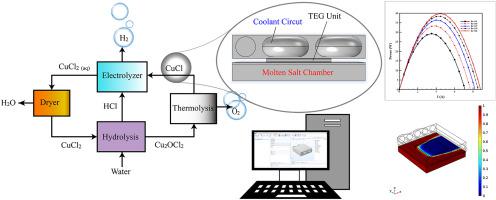International Journal of Hydrogen Energy ( IF 8.1 ) Pub Date : 2022-11-24 , DOI: 10.1016/j.ijhydene.2022.10.251 Amir Mohammadi , Ofelia A. Jianu

|
The looming threat of global warming has elicited efforts to develop reliable sustainable energy resources. Hydrogen as a clean fuel is deemed a potential solution to the problem of storage of power from renewable energy technologies. Among current thermochemical hydrogen generation methods, the thermochemical copper-chlorine (Cu–Cl) cycle is of high interest owing to lower temperature requirements. Present study investigates a novel heat exchanger comprising a thermoelectric generator (TEG) to recover heat from high temperature molten CuCl exiting the thermolysis reactor. Employing casting/extrusion method, the performance of the proposed heat exchanger is numerically examined using COMSOL Multiphysics. Results indicate that maximum generated power could exceed 40 W at the matching current of 4.5 A. Maximum energy conversion efficiency yields to 7.1%. Results demonstrate that TEG performance boosts with increasing the inlet Re number, particularly at the hot end. For the molten CuCl chamber, findings denote that there is a 36% discrepancy between highest and lowest Re numbers. Similarly, the highest efficiency value pertains to the case with the highest inlet velocity. Moreover, the highest temperature difference between inlet and outlet of the cooling water is about 28 °C and 10 °C for the lowest and highest inlet Re numbers, respectively. Average deviation from anticipated friction factor and Nusselt number are 0.31% and 12.62%, respectively.
中文翻译:

用于在制氢的热化学 Cu-Cl 循环中从熔融 CuCl 间接回收热量的新型热电发生器热交换器
迫在眉睫的全球变暖威胁促使人们努力开发可靠的可持续能源资源。氢气作为一种清洁燃料被认为是解决可再生能源技术储能问题的潜在解决方案。在目前的热化学制氢方法中,热化学铜氯(Cu-Cl)循环由于温度要求较低而备受关注。本研究调查了一种新型热交换器,该热交换器包含热电发电机 (TEG),用于从离开热解反应器的高温熔融 CuCl 中回收热量。采用铸造/挤压方法,使用 COMSOL Multiphysics 对所提出的热交换器的性能进行数值检查。结果表明,在 4.5 A 的匹配电流下,最大产生功率可超过 40 W。最大能量转换效率为 7.1%。结果表明,TEG 性能随着入口 Re 数的增加而提高,特别是在热端。对于熔融的 CuCl 室,研究结果表明最高和最低 Re 值之间存在 36% 的差异。同样,最高效率值与最高入口速度有关。此外,对于最低和最高入口 Re 值,冷却水入口和出口之间的最高温差分别约为 28 °C 和 10 °C。与预期摩擦系数和努塞尔数的平均偏差分别为 0.31% 和 12.62%。结果表明最高和最低 Re 值之间存在 36% 的差异。同样,最高效率值与最高入口速度有关。此外,对于最低和最高入口 Re 值,冷却水入口和出口之间的最高温差分别约为 28 °C 和 10 °C。与预期摩擦系数和努塞尔数的平均偏差分别为 0.31% 和 12.62%。结果表明最高和最低 Re 值之间存在 36% 的差异。同样,最高效率值与最高入口速度有关。此外,对于最低和最高入口 Re 值,冷却水入口和出口之间的最高温差分别约为 28 °C 和 10 °C。与预期摩擦系数和努塞尔数的平均偏差分别为 0.31% 和 12.62%。


















































 京公网安备 11010802027423号
京公网安备 11010802027423号